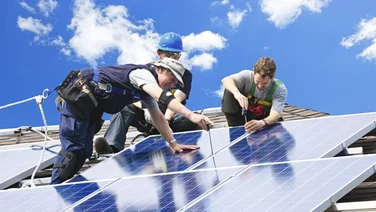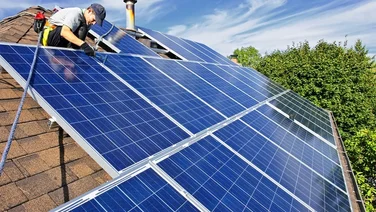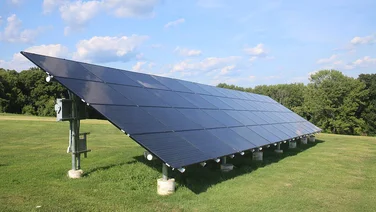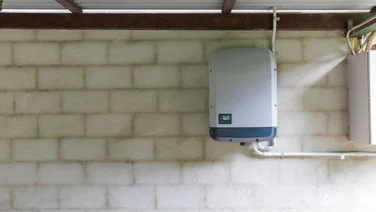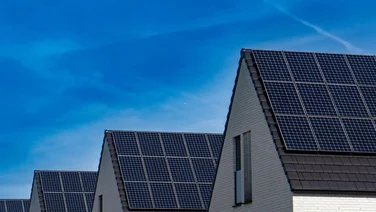- A green roof is a layer of vegetation on top of a building
- A green roof could reduce a building’s summer energy demands by 75%
- Green roofs cost an average of £8-17 per square foot
Green roofs are not a new invention. The Babylonians got the ball rolling with their exquisite Hanging Gardens in 500BC, more modern innovations such as the various types of solar panels can help make your home ‘greener’ in a different way.
Today, the interest in green roofs is ballooning, with cities all over the world attempting to greenify their grey tops. While places like Singapore may be leading the way, the UK’s own green roof market is growing by 17% every year.
So what does this mean for solar power? In this article, we’ll tell you everything you need to know about green roofs, how they compare to solar panels, the upfront costs of solar panels vs green roofs, and whether the two are actually mutually exclusive.
Where do you want to install solar panels?
Get started
What is a green roof?
If you haven’t heard of a green roof before, you’ve probably already guessed what it is.
Put simply, a green roof is a layer of vegetation on top of a building, ranging from a thin coating of grass to full-blown gardens that you can walk around in.
Don’t get the wrong idea, though. A building with a green “roof” still has a proper brick-and-mortar roof underneath all that greenery.
The two types of green roof
Yes, there’s a well-recognised spectrum of green-roofiness. Ultimately, it’s all based on how similar the roof is to a proper, ground-rooted garden.
Extensive green roofs
Think thin and flat. An ‘extensive’ green roof usually comprises succulents, mosses, herbs, and grasses. It’s typically about 1-6 inches thick, and weighs around 7-23kg per square foot.
The plants selected are fairly resistant to tough weather conditions, so the roof is extremely low maintenance. This makes it the more economical type of green roof.
An extensive green roof is usually inaccessible for people to walk around – it’s just left up there for aesthetic and environmental reasons.
Before we go on, to avoid any confusion, we should clarify what ‘extensive’ means in this context. This kind of ‘extensive’ is in the agricultural sense, meaning “obtaining a small crop without much labour or capital”.
Where do you want to install solar panels?
Get startedIntensive green roofs
If you’re going to put plants on your roof, why not do it properly? An ‘intensive’ green roof is basically a garden in the sky – trees and all – typically measuring up to 2m tall, and weighing up to 60-70kg per square foot.
It requires a proper irrigation and drainage system, along with additional ‘root protection’ layers. This means it’s very high maintenance, and much more expensive than an extensive green roof.
However, you get what you pay for – an intensive green roof usually includes walkways and benches, so people can enjoy the roof like they would a garden.
Everything in between
Of course, it’s not this black and white. You’ll commonly find semi-intensive and semi-extensive green roofs, desperate to resist definition.
Why are green roofs better than normal roofs?
A sensible question! Other than to make things look nicer for overhead birds and people in helicopters, what’s the point of a green roof? Well, the list of benefits is long.
Natural insulation
This is the key reason humans have constructed green roofs since time immemorial. These green lids will keep the heat in and the cold out, slashing its mother-building’s energy bills in the process. Compared to a standard roof, which can seriously overheat in the summer, a green roof will always remain at air temperature.
Indeed, a study in Canada found that a six-inch thick extensive green roof has the potential to reduce a building’s typical summer energy demands by 75%.
Crucially, green roofs help to negate the Urban Heat Island Effect, which describes the process of buildings and roads trapping heat (yes, this happens in British summers too). As tarmac, brick, and metal trap heat, it increases the demand for air-con, which means more energy consumption.
In contrast, green roofs are not made from reflective or impermeable materials. The leaves help to absorb heat and provide shade, while the process of evapotranspiration helps to cool the air. The result? Less money spent on air-con.
Longer lifespan
Green roofs protect the building’s roof membrane from UV radiation and harsh weather. According to Gardenista, green roofs can double, or even triple the lifespan of a standard roof.
Looks beautiful
There is no question that a garden on top of a building looks better than brick or metal. Bursts of natural greenery across a concrete skyline can rescue the appearance of even the most mundane cities. What’s more, living amidst plants and trees is a proven way of maintaining one’s mental health.
Of course, if a building is extremely tall, it won’t be possible for people on the pavement to see the garden on top – but in most cases, this isn’t an issue. Why? Well, the majority of green roofs tend to spill over the sides of buildings, so everyone can always see a green edge – even on the tallest of skyscrapers.
Less urban flooding
Combine rainfall with impermeable surfaces, and you’ve got yourself a flood. In cities where heavy rain is a regular occurrence, the raindrops simply roll off the buildings (known as ‘surface runoff’), and the roads can fill up like basins.
In contrast, green roofs are ideal interceptors – the leaves lap up the raindrops as they fall, the soil catches the rest, and the roots absorb it from the soil. Plants do this to help themselves, but they’re inadvertently protecting the city in the process.
Improves the air quality
Plants remove harmful particulates from the air around them, and emit oxygen. Metal and brick roofs do not do this.
Provides animal habitats
This one’s for the animals out there! Along with all the benefits for humans, green roofs also offer urban critters a new place to call home. You know, one that reminds them of a happier time, before man came.
How much does a green roof cost?
According to Gardenista, a typical four-inch extensive green roof costs approximately $10-20 per square foot, or around £8-17 per square foot. And according to this UK based green roof site, an extensive green roof on the average English home would cost around £7,000. Pricey, but for the life expectancy improvements alone more than worth it.
Green roofs compared to solar panels
Green roofs and solar panels are generally seen as mutually exclusive.
This isn’t actually the case (see further down the page), but if you’re choosing between the two, which would serve you better? We’ve broken this head-to-head down into categories.
Cost and ROI
Solar panels tend to cost a fair bit more than green roofs, but you’ll break even on your investment much quicker with solar.
As we’ve stated above, a standard four-inch extensive green roof costs around £8-17 per square foot, while 350W solar panels cost around £26 per square foot.
Of course, you can get less powerful panels for a cheaper price, but 350W is pretty much the standard size of most decent residential solar panels.
So yes, you’ll spend more if you choose solar – though the break-even point is 13-15 years. That’s right: buy a 3.5kW solar PV system now, and recoup your money in its early teens, offering a clear answer to the often-asked question of whether solar panels are worth it in the UK.
Meanwhile, according to a study by the University of Illinois, you’ll break even on a standard green roof in approximately 73 years. And we’re not even sure if some green roofs can last that long.
Environmental impact
This one’s a tough call. In terms of preventing carbon emissions, solar panels perform better than green roofs. However, there are lots of ways to measure environmental impact, and green roofs certainly have a more diverse skill set.
According to the Energy Saving Trust, a typical 4kWp solar PV system in the UK measures approximately 30 square metres, and prevents between 1.3 and 1.6 tonnes of carbon dioxide from entering the atmosphere each year.
In other words, that’s 1.45 tonnes of carbon dioxide prevented by 323 square feet of solar panels each year. That equates to about 0.005 tonnes of carbon dioxide per square foot.
To work out the equivalent for green roofs, we’ve used a case study from the US Environmental Protection Agency (EPA), which focuses on the green roofs of Kansas City, Missouri.
According to this study, the 734,826 square feet of green roofs in Kansas City will prevent 1,150 tonnes of carbon dioxide from entering the atmosphere in 2020. This equates to about 0.002 tonnes of carbon dioxide per square foot.
So, it’s a fairly close one, but solar panels edge it past green roofs by 0.003 tonnes of CO2.
However, assess ‘environmental impact’ by alternative measures, and it’s a different story. Those green roofs in Kansas City will also remove 90lbs of harmful particulate matter (PM2.5) from the atmosphere – compare this to solar panels’ 0lbs.
Green roofs help to negate the effects of acid rain (again, solar panels do nothing to help); they create new habitats for animals (solar panels don’t cooperate with wildlife), and they also absorb sulphur dioxide and nitrogen oxide.

Energy bill savings
In terms of how much money you’ll save on bills, solar panels will give you more.
According to the Energy Saving Trust, a 4kWp solar PV system in the southeast of England can save a family £507 per year (even if they’re out all day until 6pm). Again, based on the 30 square metres / 323 square feet typical system size, that’s £1.50 of energy bill savings per square foot of solar panel each year.
Let’s take a look at Kansas City again. Its 734,826 square feet of green roofs will provide energy bill savings worth $41,587 in 2020, or £35,337. That’s £0.05 of energy bill savings per square foot of green roof each year.
Longevity
Green roofs tend to last longer than solar panels.
While solar panels typically come with a warranty of 25 years (and a lifespan of 30-40 years), there’s no reason why a green roof can’t last upwards of 60 or 70 years. For example, many of the green roofs constructed in Europe in the 1960s are still thriving.
What’s more, solar panel technology advances so quickly that it won’t be long until your premium ‘hi-tech’ panels are a little outdated. On the other hand, evolution sorted plants out quite a while ago, so there are no big updates on the cards.
Maintenance
If you want your green roof to last a lifetime, you’ve got to earn it. While solar panel maintenance is very minimal (although solar panels should be cleaned annually), a garden on your roof requires as much attention as, well, a garden. If you want a proper intensive green roof with trees and bushes, you’ll need to check up on it regularly, as well as performing frequent maintenance checks on your green roof’s irrigation system.
To dodge the maintenance faff, an extensive green roof with just grass and moss will be significantly less taxing.
Aesthetics
However sleek, black, and modern these manufacturers make their solar panels, no styling of glossy silicon will ever trump the appearance of real greenery.
Can you have solar panels and a green roof?
Yes! Commonly thought to be mutually exclusive, solar panels and vegetation can coexist on the same rooftop.
What’s more, when you combine the two together, both perform better. It’s a symbiotic win-win. How do we know this? A 2017 study by the University of Illinois came to some pretty emphatic conclusions.
How does a green roof help solar panels?
Layers of dust and air pollutants gradually build up on solar panels over time, affecting their efficiency and output. However, plant life helps to keep the surrounding air clean, meaning that solar panels on a green roof stay clean and efficient for longer (that means less solar panel cleaning for you).
Vegetation also helps to keep surrounding temperatures fairly cool, which is important for solar panels. Solar PV systems tend to become less effective in hot summer temperatures, with most panels experiencing a decline of 0.3-0.4% for every 1°C increase above 25°C.
How do solar panels help a green roof?
Solar panels help to create a variety of different conditions on one roof. For example, by sloping downwards at a 45 degree angle, rain runs off the front and creates damp patches, while the area at the back of the panels remains dry. Likewise, parts of the roof become shaded by the panels, while others stay exposed to the sun.
This might sound like the panels are merely interfering with the garden, but these varied conditions help to create a much wider variety of plant life – a ‘habitat mosaic’. With said ‘mosaic’ in place, it’s an invitation for a similarly wide variety of wildlife to move in and make it home.
In essence, the solar panels significantly improve the offering that a green roof makes to urban fauna.
Should you combine the two?
The question is less about ‘should’ and more about ‘can’. Yes, the benefits of having both on your roof are clear – but naturally, you’ll have to pay for both.
The pros and cons of green roofs
| Pros | Cons |
| Improves the building’s insulation, decreasing heating and air-con costs | Not all buildings are structurally suitable for the weight of a green roof |
| Increases property value | Significantly more expensive than traditional roofs |
| Absorbs rainfall, reducing the likelihood of flooding | High maintenance |
| Creates habitats for urban wildlife | |
| Reduces carbon emissions and absorbs PM2.5 particulates | |
| Looks beautiful |
Summary
Green roofs are wonderful additions to a building. If you can front the cost and be bothered with the upkeep, having a garden on your roof is a bit of a no-brainer.
However, if you’re weighing up the choice between a green roof and solar panels, and you’re obliged to pick just one, we heartily recommend solar panels.
They’re more expensive at the outset, but they also have a much quicker ROI, a much bigger effect on CO2 emission reduction, lower maintenance costs, and a larger impact on your energy bills.
Add this to the fact that 65% of people are likely to buy a home with solar panels, and you have a great long-term investment.
To receive quotes for solar panels from local, trusted installers, simply pop your details in this form. Or, take a look at this gorgeous collection of green roofs from around the world.


